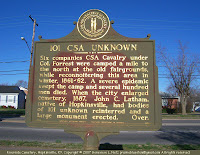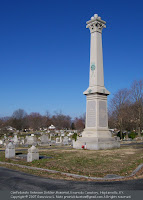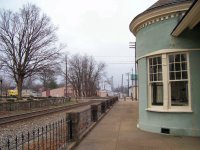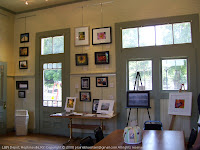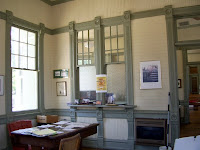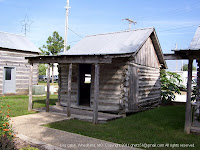Seen in old plat book of Brown County, Nebraska
Recently, I came across a 1912 plat book of Brown County, Nebraska. The original copy is held by the Library of Congress, and Ancestry.com has images of the pages.
In it, I found the locations of land that belonged to three sets of my ancestors (see endnote). They were all neighbors to each other in southwestern Brown County's Lakeland and Moon Lake precincts.
I recognized the names of many of their neighbors as people my dad knew. And I realized that I knew at least two of the 1912 landholders myself -- my great grandfather Charles Clark (who lived until 1972) and Jess McDaniel (whom I remember as an old man with white hair in the mid-1950s.)
My father, born in the Moon Lake area in 1923, had boyhood memories of going to Johnstown and Wood Lake with the wagon for supplies. These small villages west of Ainsworth were the closest settlements, and I think that's where my Mapes grand-uncle and my Hill, Fisher, and Clark grandparents would have gone for most supplies in 1912. Still, I am sure that they visited Ainsworth sometimes for legal matters, because Ainsworth was the county seat of Brown County.
Ainsworth probably seemed a large town to homesteaders. The platbook's images of Ainsworth show two-story commercial buildings and white frame houses with porches -- presumably the showiest structures in town. (Scroll down about 2/3 of the way on this
Brown County genealogy page for links to similar photos of Ainsworth in that era.)
As my ancestors drove down the dirt streets of Ainsworth in a horse-drawn wagon (prepared to haul home a load of supplies), they might have seen some of the following firms that advertised in the 1912 plat book:
Hotel and restaurant:
The Osborne House: "We have our own dairy, poultry and garden, and serve the best of everything. In winter, this is the warmest house in the northwest. Steam heat throughout. Meals are ready one hour before all trains. A large, well lighted sample room free. We want your business and will do our best to deserve it. Sportsmen's goods are cared for while you hunt or fish, without extra charge. If you can't stay all night, eat with us -- 'Every Little Bit Helps.'" Philip Mensinger, Prop.
Supplies for riding and driving horses
Sam Schneider & Son: "Harness, Saddlery Blankets, Robes, Whips, and other Horse Clothing and Leather Goods"
Three places to rent or board a horse:
Fisk Livery Feed & Sale Stable
Fry Bros. Livery and Feed Barn
S. B. Turner Proprietor, Livery, Feed, and Sale Barn. "Driver Furnished if desired."
Metal and Wheel Work
Henry Coad, Blacksmith and Wheelwright: "Repairing a specialty"
Two dentists (I shudder to think!)
G.D. Shipherd, Dentist
Dr. J. M. Jessen, Dentist
Two newspapers
The Brown County Democrat: "A country newspaper, published where the corn and potatoes grow, in the heart of a rich agricultural district."
The Star Journal
Produce dealer
Ross Smith: "Buyer of Cream, Poultry, and Country Produce"
Two banks
Citizen's State Bank,
National Bank
Two auctioneers
Col J. H. Hart: "Many years of practical service in his line have demonstrated his ability. See him if you are thinking of having a sale."
Claude E. Smith: "Have you sold or rented your farm? That's your business. Are you going to have a sale? That's everybody's business. Do you need a good auctioneer? That's MY business."
Four Real Estate Agents
(It was not uncommon for people to homestead, gain title to their land after five years, and then sell it.)
Richardson & Suell, Real Estate & Insurance Agents
Geo. P. Reynolds, The Land Man
McSweeney Land Company
Northwestern Land Company
Wells
(I notice that this fellow doesn't dig wells. He drills them.)
Thos. S. Bower, Well Drilling and Boring, Tanks, Pumps, and Supplies
Lawyers
A. W. Scattergood, Attorney at Law
Wm. M. Ely, Attorney at Law
Modern technology
Ainsworth Telephone Company
Reeves & Bailey Automobiles
Two lumber yards and coal dealers
Krotter & Hall Lumber Co.: "Dealers in Building Materials, Coal, Hardware, Grain and Implement, Yards at Long Pine, Johnstown, Crookston, Georgia, and Merriman."
(These little towns were east and west of Ainsworth on the railroad.)
Excelsior Lumber Co.: "Lumber, Coal, Flour, Feed, Grain, Agricultural Implements, Buggies, and Farm Wagons. Roller Mill and Elevators."
Building contractors and subcontractors:
W. E. Moseley, Building Contractor
L. P. Barnes Concrete: "Sidewalks, Porches, Doors, Door and Window Caps and Sills, Foundations"
Shopping:
Munson & Howe General Merchandise
Baldwin Brothers: "Hardware, Paints, Oils, Furniture, Carpets, Rugs"
H. House & Son: "Fine Furniture"
Suell & House Clothing
Larson & Son: "Merchant Tailors"
Note:
I usually say that my ancestors had
ranches in southwestern Brown County, because the Sandhill land was much better for grazing, than it was for farming. One of them is officially listed as a "stockman" in the back of the 1912 plat book. However, if my ancestors homesteaded under the original Homestead Act, they were required to farm (to plow and plant) a portion of the land. I have found the homestead papers for the Clark and Hill grandparents and the Mapes great-uncle, but not the Fisher grandparents. I have not researched what homestead requirements any of them had to meet.
















